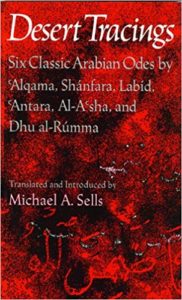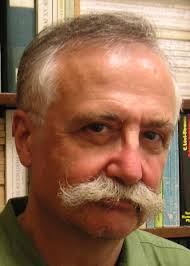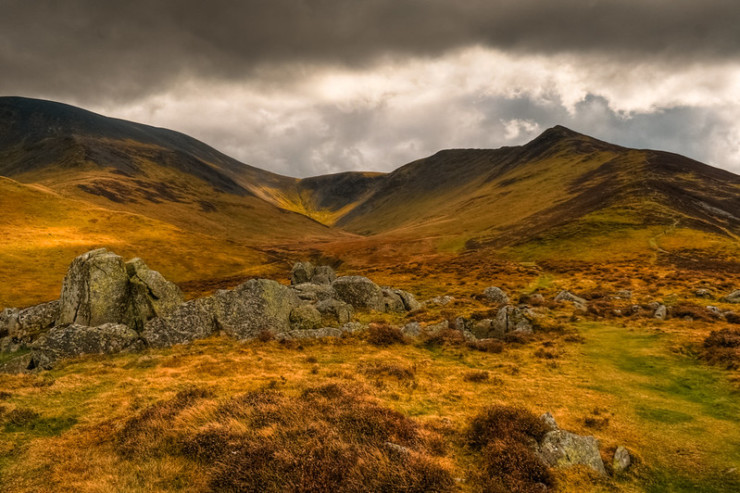In the Arabian Peninsula before Islam (started 622 A.D.), Bedouin tribes roamed the land. With their roaming they developed a long, rich tradition of oral poetry. After the rise of Islam, many of the Arabian poetic forms were incorporated into the Koran and other Islamic writings. But as the writing of poetry shifted from the desert to the cities like Baghdad, Basra, and Aleppo, this oral tradition declined.
Fortunately, Islamic scholars copied and preserved the old poems of the desert, Michael Sells says in Desert Tracings: Six Classic Arabian Odes. Sells, a longtime professor of pre-Islamic and Islamic literature at the University of Chicago, has collected and translated six of the most famous Arabian odes. The collection opens a door to an oral poetic tradition little known in the West.
As Sells points out, we don’t know who the original authors were, the precise location of their origins, or how the poems were transmitted into the hands of the scholars who wrote them down. What we do know is what they share in common. Arabian odes are rarely longer than 120 lines, and they are generally divided into three parts — the remembrance of the beloved (not always a person), a journey, and a boast.
The six odes in Desert Tracings are about love, violence, exile, beauty, and searching or a quest. Some of the poems include all of these themes. The most famous of the odes is “Arabian Ode in ‘L,’” attributed to an author named Shanfara, the hero of the ode. He is an outcast, exiled from or abandoned by his tribe for some undisclosed crime or behavior. Shanfara, embittered by the experience, claims that the desert wolf, leopard, hyena, and his own weapons of sword and bow are better friends than anyone from the tribe that has cut him off.
From “Arabian Ode (Rhyming) in ‘L’”

and leave, sons
of my mother. I lean to a tribe
other than you.
What must be is at hand.
The moon is full,
mounts and saddle frames secured
for distant crossings.
In this land is a refuge for a man
from wrongs,
for one fearing scalding hatred,
a place to withdraw,
By your life! It crowds on no man
who travels by night,
in fear or in desire,
and keeps his wits about him.
I have in place of you other kin:
the wolf, unwearying runner,
the darting sand leopard,
the bristle-necked hyena.
These are my clan. They don’t reveal
a secret given in trust,
and they don’t abandon a man
for his crimes.
All of the translated odes follow this format and include similar themes. The final ode in the collection, “To the Encampments of Mayya,” stands at the border of pre-Islamic poetry and what came after it. The primarily oral, desert-based poetic tradition was transformed as Islam spread and cities rose as centers of poetry writing and scholarly activity.

Michael Sells
Sells is the John Henry Barrows Professor of Islamic History and Literature in the Divinity School and in the Department of Comparative Literature at the University of Chicago. His areas of expertise and teaching include Sufism, Arabic and Islamic love poetry, mystical literature, and religion and violence.
He’s published three works on Arabic poetry: Desert Tracings: Six Classic Arabian Odes (1989); Stations of Desire (2000), which focuses upon the love poetry of Ibn al-ʿArabi; and The Cambridge History of Arabic Literature, al-Andalus (2000) (co-editor and contributor). He’s also published Early Islamic Mysticism (1996), Mystical Languages of Unsaying (1994); The Bridge Betrayed: Religion and Genocide in Bosnia (1996); The New Crusades: Constructing the Muslim Enemy (2004) (co-editor and contributor); and many others.
Desert Tracings, first published in 1989, is a window on a culture and a poetic tradition that, though long disappeared in the desert sands, survived in new ways and influences. The spirit and even the form of the Arabian ode lived on in both the Islamic faith and in its poetry.
Photo by sagesolar, Creative Commons, via Flickr. Post by Glynn Young.
__________________________

“I require all our incoming poetry students—in the MFA I direct—to buy and read this book.”
—Jeanetta Calhoun Mish
- Longfellow’s “Paul Revere’s Ride”: Creating a National Legend - April 17, 2025
- Poets and Poems: Katie Kalisz and “Flu Season” - April 15, 2025
- Poets and Poems: Michelle Ortega and “When You Ask Me, Why Paris?” - April 10, 2025

Sandra Heska King says
“Arabian odes are rarely longer than 120 lines, and they are generally divided into three parts.”
Guessing that set-up made them easier to memorize. 🙂
Megan Willome@yahoo.com says
Good thought, Sandy!
I like learning about a form of poetry that is unfamiliar and one that has a long and rich tradition. The part of the poem you included sounds so contemporary in its boasting.